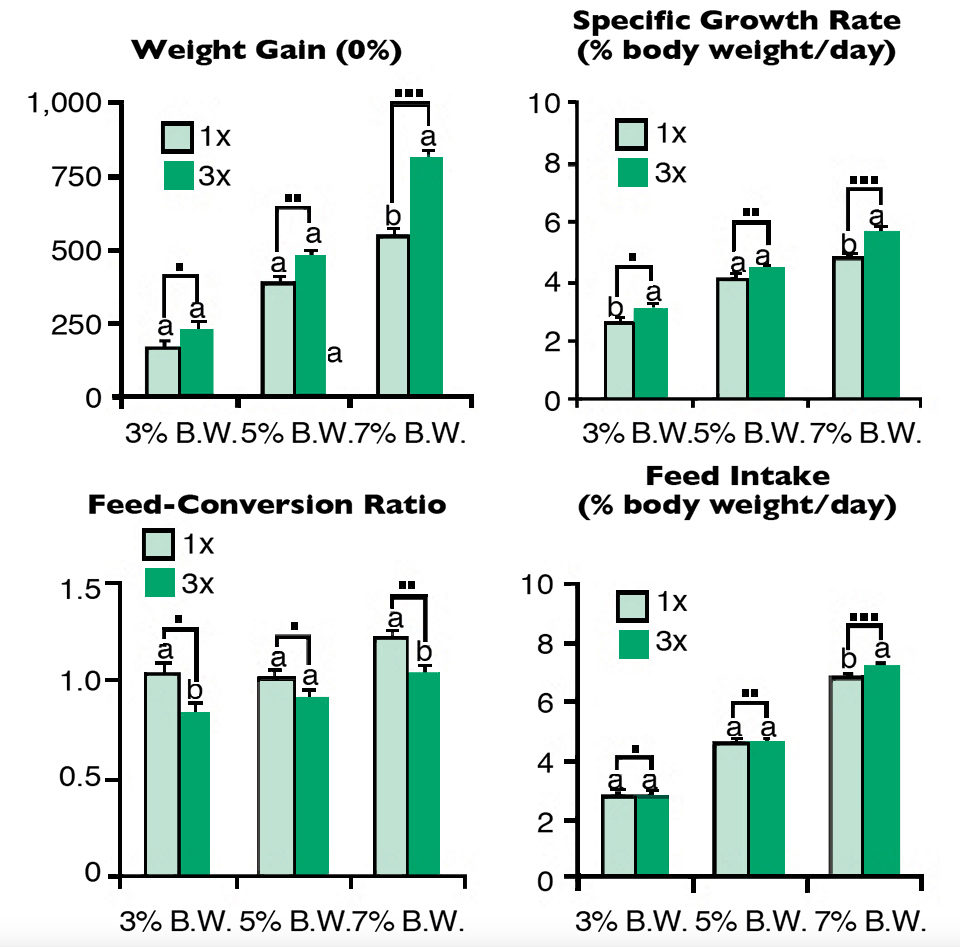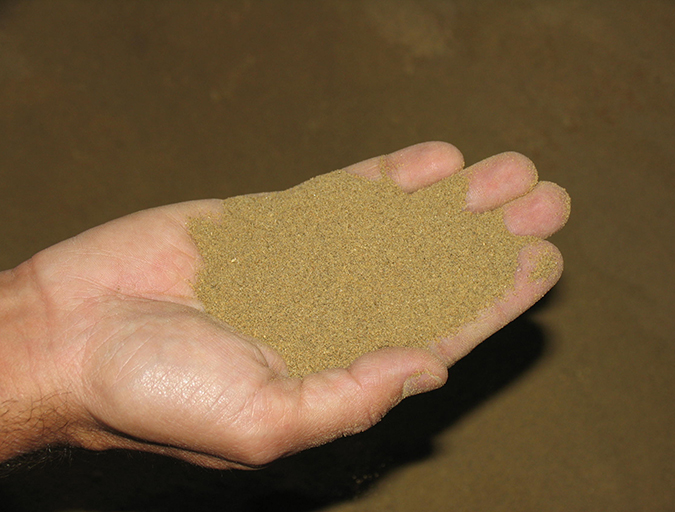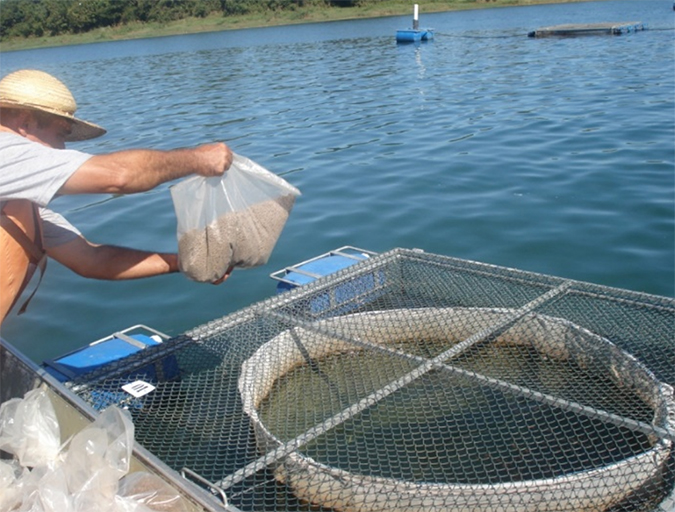Growth efficiency reduced at a daily feeding rate of 7 percent of body weight

The Atlantic spadefish (Chaetodipterus faber) inhabits the western Atlantic waters from the United States to southern Brazil. This species is well recognized by recreational fishermen, but not by commercial fisheries due to its affinity for submerged objects that make net fishing techniques inefficient. Little work has been done to determine the potential of intensive Atlantic spadefish aquaculture, but the species exhibits several desirable characteristics, including rapid growth, broad salinity and thermal tolerance, ready adaption to confinement and little cannibalistic behavior. Additionally, Atlantic spadefish have excellent flesh quality and striking black and white coloration, suggesting they have potential in both seafood and ornamental markets.
Feeding rate, frequency study
Successful development of aquaculture for an emerging species involves establishing husbandry methods, including identification of appropriate feeds and feeding regimens. Feed management strategies for feeding rates and frequency affect fish performance and are also primary determinants of production costs. Feeding at the optimum rate and frequency will improve growth efficiency, yield greater size-class homogeneity, minimize wastes and associated effluents, and reduce production costs.
Conversely, improper selection of feeding rates and frequencies will likely impair production performance. For example, sporadic feeding and low feeding rates can contribute to reduced growth, as well as increased hunger, intraspecific aggression and cannibalism. Alternatively, frequent feeding and high feeding rates can lead to feed wastage, deteriorating water quality, reduced fish growth and higher production costs.
To identify appropriate feeding rates and frequencies for Atlantic spadefish, the authors evaluated the growth performance and carcass composition of juvenile spadefish fed daily at 3, 5, or 7 percent body weight in a single or three equal feedings.
Results
After 39 days, growth performance was affected by feeding regimen. Weight gain and specific growth rate increased significantly with feeding rate, and growth was generally greater and more efficient in the groups fed three times a day than in the once-daily groups. Fish fed at higher feeding rates accumulated significantly more lipid within their bodies and had associated decreases in moisture, protein and ash content. However, carcass composition was not affected by feeding frequency.
Based on the study results, feeding three times daily was advantageous, regardless of the feeding rate (Fig. 1). A significant interaction between feeding rate and frequency was noticed for weight gain, suggesting the performance-enhancing effects of more-frequent feeding was more pronounced among fish fed at higher rates (Fig. 2). It is not surprising that feeding at higher rates yielded greater weight gain, as increasing the feeding rate increased the availability of amino acids, structural lipids and energy for growth.


However, if any of the required elements for somatic growth became limiting – certain amino acids or phospholipids, for example, or if nutrient intake simply exceeded the requirements of the fish, the surplus resources would be lost via fecal losses or reflected in increased carcass levels of glycogen, triglycerides or other energy storage products. Feed-conversion ratios could also increase over time.
The study data illustrated this pattern quite clearly. Regardless of feeding frequency, Atlantic spadefish that were fed at higher rates gained more weight. But growth efficiency was reduced at a daily feeding rate of 7 percent of body weight, and the composition of the gain was increasingly skewed toward greater adiposity.
Perspectives
Of the feeding rates and frequencies evaluated, the authors suggest the performance of juvenile Atlantic spadefish is optimized when they are fed daily at 5 to 7 percent body weight in three feedings. Feeding at 7 percent body weight/day yielded the greatest, albeit slightly less efficient, growth.
Editor’s Notes: This article was based on an article published by the authors in the North American Journal of Aquaculture. This article was published in the January/February 2015 print edition of the Global Aquaculture Advocate.
Authors
-

Jesse T. Trushenski, Ph.D.
Center for Fisheries, Aquaculture and Aquatic Sciences
Southern Illinois University
1125 Lincoln Drive, Room 251
Carbondale, Illinois 62901 USA -

Artur N. Rombenso
Center for Fisheries, Aquaculture and Aquatic Sciences
Southern Illinois University
1125 Lincoln Drive, Room 251
Carbondale, Illinois 62901 USA -
John Bowzer
Center for Fisheries, Aquaculture and Aquatic Sciences
Southern Illinois University
1125 Lincoln Drive, Room 251
Carbondale, Illinois 62901 USA -
Brian Gause
Center for Fisheries, Aquaculture and Aquatic Sciences
Southern Illinois University Carbondale
1125 Lincoln Drive, Room 251
Carbondale, Illinois 62901 USA -

Michael H. Schwarz, Ph.D.
Virginia Seafood Agricultural Research and Extension Center
Virginia Tech
Hampton, Virginia, USA
Tagged With
Related Posts

Aquafeeds
A look at phospholipids in aquafeeds
Phospholipids are the major constituents of cell membranes and are vital to the normal function of every cell and organ. The inclusion of phospholipids in aquafeeds ensures increased growth, better survival and stress resistance, and prevention of skeletal deformities of larval and juvenile stages of fish and shellfish species.

Aquafeeds
A look at protease enzymes in crustacean nutrition
Food digestion involves digestive enzymes to break down polymeric macromolecules and facilitate nutrient absorption. Enzyme supplementation in aquafeeds is a major alternative to improve feed quality and nutrient digestibility, gut health, compensate digestive enzymes when needed, and may also improve immune responses.

Aquafeeds
A look at the SME controlled extrusion process
A study was conducted using a Twin-Screw Extruder equipped with Specific Mechanical Energy (SME) and Density Control valves, to determine the effect of SME on the water stability of shrimp feeds. Further research is needed to evaluate the performance.

Health & Welfare
Aiding gut health with a natural growth promotor
A study with Nile tilapia conducted in commercial production cages in Brazil showed the potential – in the absence of major disease threats – of a commercial, natural growth promotor that modulates the microbiota (inhibiting growth of pathogenic bacteria and promoting growth of beneficial bacteria) and inhibits quorum sensing.


